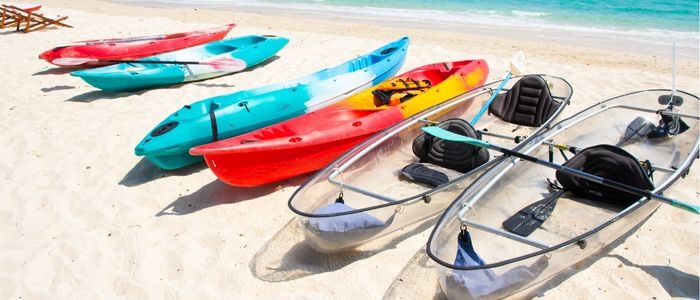
Both kayaks and Jon boats are used for fishing, but these two types of boats are different in some important ways. Whether you are an angler, water sports enthusiast or hunter, understanding the nuances of kayaks and Jon boats can help you make an informed decision.
In this kayak vs Jon boat article, I’m going to discuss everything you need to know about them—their types, similarities, differences, advantages and disadvantages. Hopefully this post will help you choose the right fishing vessel. Keep reading!

A kayak is a long, narrow boat with a cockpit, in which the kayaker sits. There may be multiple cockpits in a kayak. The deck is covered to safeguard the kayaker from water sprays and UV rays. A standard kayak is about 10 feet long. It is usually manually driven, but you can put a motor on it.
Kayaks are made of a variety of materials such as plastic, polyethylene or fiberglass. These vessels are more suitable for small bodies of water. New models of kayaks are getting larger, heavier and more stable.

It’s a motorized boat with bench seating and a flat bottom. The number of seats depends on the size of the boat. Unlike a kayak that has a pointed and angular bow, a Jon boat has a square-shaped bow. This is the most notable difference between these two types of boats.
Jon boats are made of materials such as polyethylene, fiberglass, wood or aluminum. Wooden Jon boats are treated to make them waterproof and weatherproof. While fiberglass is pretty strong, it’s sensitive to cracking and scratching.
All kayaks are roughly the same shape, but they differ to some extent in terms of styles and features. Here are several styles available on the market:
Different types of kayaks are designed to be used in different types of environmental conditions. A fishing kayak may come with a hybrid design characterized by features for dealing with ocean waves.
Flat-bottomed kayaks are used in calm inland waters, mostly for leisure activities. These kayaks are not suitable for the open ocean. It is to be noted here that many kayaks are designed for multi-purpose use, and come with different hull features.
A hybrid fishing kayak is mostly used for ocean fishing. Its stability comes from its flat bottom, and it has other features to deal with waves.
To resolve your kayak vs Jon boat dilemma, it will be helpful to know that Jon boats vary in their styles. There are two basic types of Jon boats, and we are going to discuss them below. Regardless of their designs, most Jon boats are made of aluminum.
Flat-bottomed Jon boats are more common than modified-V hulls. They are known for their simple design, and they are mostly suitable for calm waters. In general, Jon boats are not seaworthy. Well, you may consider taking your Jon boat onto the ocean, but venturing far away from the shoreline is not a good idea. You can do so only when the weather conditions are ideal.
Kayaks are different from Jon boats mainly in terms of physical appearance. A kayak is a slim and simple boat designed for just one or two people. A Jon boat, in contrast, is a motorized water vessel. You need a little bit of boating experience to navigate a Jon boat. Let’s see the differences in more detail.
Depending on their usage, kayaks are 8-23 feet long. The length of a recreational kayak is around 10 feet, and a touring kayak is 12-16 feet. An ocean kayak can measure up to 23 feet. The most widely available fishing kayaks are 10 feet long.
Jon boats are usually larger than kayaks. While Jon boats are available in many different sizes, the most widely available ones are around 24 feet long. The width of a Jon boat is 32-60 inches.
A fishing kayak weighs between 35 to 120 pounds. There are some expensive, heavier ones weighing around 200 pounds. In contrast, many Jon boats weigh around 500 pounds. That means, Jon boats are heavier than kayaks by a large margin. So, if you need a boat that you can carry easily, a Jon boat may not be a good option for you.
As we have stated, a Jon boat costs more than a kayak. An entry-level kayak costs $400-$600, and a high-quality one may cost $1000 or more. In contrast, an average Jon boat costs $550-$700. However, it will need modifications such as motors, which will add to the cost. If you are on a budget, a kayak may be the right choice for you.
Purchasing a boat is not enough. There are additional costs for modifications and upkeep, which many people tend to overlook. The maintenance cost of a Jon boat is higher, in part because you need fuel to run it, you have to store it outdoors. But you can store a kayak indoors.
In terms of customizability, Jon boats have an edge over kayaks. You can attach drink holders or coolers to your kayak, but a Job boat will give you a lot more flexibility. Jon boats are sturdy, and you don’t have to be very careful about its care and maintenance. That’s not the case with a kayak.
When faced with the choice of kayak vs Jon boat, one should know that both Jon boats and kayaks require added accessories, but Jon boats require fewer accessories. Either vessels can be modified to varying degrees, and there are thriving DIY communities that can provide you with tips, tricks and technical support.
Kayaks are easier to repair—you can use a plastic patch to patch up holes or cracks. With Jon boats, broken parts can be welded back together, but the task requires some experience. It is to be noted here that Jon boats suffer fewer wear and tear, in part because they are made of metals, especially aluminum. These boats remain just fine under normal circumstances.
Kayaks, in general, are more comfortable than Jon boats. However, cheap kayaks are not as contour-friendly as high-end models. You can easily upgrade the seat of a sit-on-top kayak.
Jon boats are roomier than kayaks. You can not only stand on the boat but also walk around. Jon boats come with bench seating, which may feel a bit uncomfortable. However, you can add a cushion and make the bench seating pretty comfortable.
Jon boats are motorized vessels, and understandably they are better than kayaks in terms of speed. While you can attach a motor to your kayak, the procedure is not that straightforward. You have to register your kayak as a boat. It’s not mandatory in all states, though. However, if you have to undergo the process, it can be a hassle.
While Jon boats are propelled by motors, kayaks are manually driven. If you own a Jon boat, you have to take care of the engine. That’s not the case with a kayak.
In order to make the right choice, you have to take three factors into consideration: the boat’s purpose, the environment in which the boat will be used, and your budget. Let’s dive a little bit deeper.
The purpose of the boat is the first fact to consider. Why do you need a boat? What will you do with it? Identifying the purpose of the boat is the first step to making a decision. Kayaks and Jon boats are often used for similar purposes, but there are some differences between them.
In this case, your purpose is fishing. But do you intend to use it as a utility boat? How much gear will you carry? Your decision should also be determined by the number of passengers.
The second consideration is the place where the boat will be used. Where do you intend to use the boat? Do you want to use the boat to navigate calm waterways or rough waters? Make sure your decision is determined by the type of water in which the boat will be used.
The factor is your budget. While the prices do not vary wildly at the lower and middle end of the spectrum, the costs can go up when you add extra features like rod holsters and outboard engine.
In general, kayaks are significantly less expensive than Jon boats, and most boat accessories available on the market are not suitable for kayaks. There are even cheap kayaks that cost less than $200.
In spite of their shallow draft, kayaks are actually very versatile. While kayaks are basically designed for shallow water usage, they can be used in a variety of watery environments. It’s a light vessel that’s easy to carry. Usually, just one person can load and unload it.
It doesn’t require any trailer for transportation, and you can transport it on a vehicle’s roof. However, that’s not the case with larger and heavier kayaks.
When you are faced with the dilemma of kayak vs Jon boat, one of the most important things to know is that kayaks are usually manually powered. By learning the right techniques, you will find it very easy to maneuver a kayak. However, if speed is important for you, a Jon boat may be a better option for you.
For calm shallow waters, Jon boats are great. These all-round boats are widely used for fishing, leisure activities, hunting, and the transportation of people and goods. Characterized by a shallow draft and flat bottom, a Jon boat is capable of navigating waters just a few inches deep. Usually, it is powered by a motor, but you can use oars or paddles instead.
Jon boats are designed for accommodating a lot of gear, and you can comfortably move around in the boat while boarding it. A Jon boat can accommodate at least two persons. If you need to carry more people and gear, you will have to choose a large boat.
The most notable downside of the Jon boat is that it is not suitable for navigating rough waters. Yes, the boat can be modified to make it capable of handling rough waters, but the basic design is just unsuitable for rough waters.
In shallow waters, the flat bottom design of a Jon boat provides stability. But the same feature becomes an issue when you are in rough waters. These vessels are not just capable of withstanding big waves.
For transportation, a Jon boat requires a trailer, in part because the boat is heavy. An average Jon boat is not too heavy for one person to move, and technically you can put it in the back of your truck. But that’s not really convenient.
Below is a table that summarizes the advantages and disadvantages of both kayaks and Jon boats.
Boat Types | Pros | Cons |
Kayaks | ● Versatile. Suitable for both shallow and deep waters ● Lightweight and easy-to-carry ● Manually powered ● Easy to maneuver | ● Slow ● Not very suitable for hunting ● Limited space. You can stand on a kayak, but there is not much space for walking around
|
Jon Boats | ● Great for inland shallow waters ● Accommodate plenty of gear ● Can be modified to a great extent ● speedy | ● Not suitable for deep and rough waters ● Not as affordable as kayaks |
A Jon boat can accommodate a fairly strong engine. While you can fit an engine with a kayak, the vessel is not designed to accommodate a large engine. So, if you are planning to cover long distances, consider getting a Jon boat. Get a kayak if you are fine with paddling over long distances. It can be fun, but it can also be tiring.
If you are a person who loves to go solo, you may find a kayak more convenient. Kayaks are remarkably cheaper, and that can be another reason to choose one.
No matter how simple a kayak you choose, it will accommodate some gear. But if you have more than the basic gear, and if you love to fish with your dog, a kayak may not be a good option for you.
It is to be noted here that there are kayaks that are even more expensive than Jon boats. For example, this 4 seater tracker Jon boat is actually cheaper than this 2 seater Pro Angler Kayak. With that said, for fishing in ocean waters, settling for a cheap boat may not be a very good idea.
When it comes to choosing a fishing boat, neither a kayak nor a Jon boat is a clear winner. Your choice should be determined by your specific needs. Jon boats have more space for gear and fare well in calm, shallow waters while kayaks are more versatile.
Making an informed decision is the key. Now that you know the similarities and differences between kayaks and Jon boats, I hope you will choose the right boat for fishing. Go ahead and get a boat you think will meet your requirements. It all comes down to your specific needs.

Hey there kayak lovers! I’m Jay Schwartz, the author here at Kayak Guidance! You know water sports – you know me! My life is all about it. Kayaking, Paddleboarding, Fishing, Snorkeling and so much more. I love to share my passion and knowledge with all of you.

Hey there kayak lovers! I’m Jay Schwartz, the author here at Kayak Guidance! You know water sports – you know me! My life is all about it. Kayaking, Paddleboarding, Fishing, Snorkeling and so much more. I love to share my passion and knowledge with all of you.

Welcome to KayakGuidance.com! If you’re looking to have some fun outdoor water adventures, then you have come to the right place. We help our readers find the best kayaks and water related equipment to help you have the best time of your life whenever you are engaging in water activities.
This site is a participant in the Amazon services LLC associates program, an affiliate advertising program designed to provide a means for sites to earn advertising fees by advertising and linking to Amazon.com.